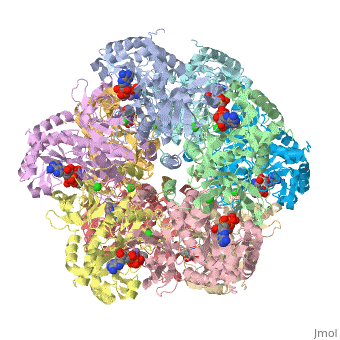Sandbox108: Difference between revisions
Taewang Lee (talk | contribs) |
Taewang Lee (talk | contribs) |
||
| Line 11: | Line 11: | ||
Tertiary structure of protein is characterized by the “global” folding of a polypeptide chain [http://www.stanford.edu/group/pandegroup/folding/education/prstruc.html] and has two domains in refined atomic model of glutamine synthetase from Salmonella typhimurium. Hydrophobic interaction is a major driving force determining the most tertiary structure of the proteins. [http://www.stanford.edu/group/pandegroup/folding/education/prstruc.html] Hydrogen bonding <insert wiki showing the H.B> is crucial in stabilizing the tertiary structure as well. [http://webhost.bridgew.edu/fgorga/proteins/proteins.htm] Also, disulfide bonds <insert wiki showing the disulfide bonds of cysteine> between cysteine residues stabilize the tertiary structure. [http://webhost.bridgew.edu/fgorga/proteins/proteins.htm] | |||
Glutamine synthetase from Salmonella has twenty three helix-helix interactions and is four different types of interactions. [http://www.ebi.ac.uk/thornton-srv/databases/cgi-bin/pdbsum/GetPage.pl?pdbcode=2gls&template=protein.html&o=HELIX_INTERACTIONS&l=1&s=1&c=7&chain=A] Hydrophobic/polar <hydrophobic/polar wiki> (put color) and hydrophilic <hydrophilic wiki>(put color) region of glutamine are combined together to fold proteins. | |||
is within uncharged polar <insert wiki showing the uncharged polar groups>. Usually, uncharged polar groups are classified as hydrophilic <insert wiki showing the hydrophilic> that is found on the outside of proteins. Also, amino acids with the character of acidic or basic side chains are polar, showing on the outside of molecules <insert wiki showing the polar>. For glutamine, its side chain is uncharged and formed by replacing the hydroxyl of glutamic acid with an amine functional group. [http://en.wikipedia.org/wiki/Glutamine] In the other hand, glutamine has no side chain on non-polar group, however the side chain on non-polar groups of the proteins usually tends to be hydrophobic <insert wiki showing the hydrophobic of cysteine> and to cluster together on the inside.[http://www.bmb.uga.edu/wampler/tutorial/prot3.html] | is within uncharged polar <insert wiki showing the uncharged polar groups>. Usually, uncharged polar groups are classified as hydrophilic <insert wiki showing the hydrophilic> that is found on the outside of proteins. Also, amino acids with the character of acidic or basic side chains are polar, showing on the outside of molecules <insert wiki showing the polar>. For glutamine, its side chain is uncharged and formed by replacing the hydroxyl of glutamic acid with an amine functional group. [http://en.wikipedia.org/wiki/Glutamine] In the other hand, glutamine has no side chain on non-polar group, however the side chain on non-polar groups of the proteins usually tends to be hydrophobic <insert wiki showing the hydrophobic of cysteine> and to cluster together on the inside.[http://www.bmb.uga.edu/wampler/tutorial/prot3.html] | ||
Revision as of 01:26, 17 December 2008
Glutamine synthetase assignment by UMBC undergraduate studentsGlutamine synthetase assignment by UMBC undergraduate students
| |||||||||
| 2qc8, resolution 2.60Å () | |||||||||
|---|---|---|---|---|---|---|---|---|---|
| Ligands: | , , , | ||||||||
| Gene: | GLUL, GLNS (Homo sapiens) | ||||||||
| Activity: | Glutamate--ammonia ligase, with EC number 6.3.1.2 | ||||||||
| Related: | 2ojw | ||||||||
| |||||||||
| |||||||||
| Resources: | FirstGlance, OCA, RCSB, PDBsum | ||||||||
| Coordinates: | save as pdb, mmCIF, xml | ||||||||
OUTLINEOUTLINE
Tertiary Structure
Tertiary structure of protein is characterized by the “global” folding of a polypeptide chain [1] and has two domains in refined atomic model of glutamine synthetase from Salmonella typhimurium. Hydrophobic interaction is a major driving force determining the most tertiary structure of the proteins. [2] Hydrogen bonding <insert wiki showing the H.B> is crucial in stabilizing the tertiary structure as well. [3] Also, disulfide bonds <insert wiki showing the disulfide bonds of cysteine> between cysteine residues stabilize the tertiary structure. [4]
Glutamine synthetase from Salmonella has twenty three helix-helix interactions and is four different types of interactions. [5] Hydrophobic/polar <hydrophobic/polar wiki> (put color) and hydrophilic <hydrophilic wiki>(put color) region of glutamine are combined together to fold proteins.
is within uncharged polar <insert wiki showing the uncharged polar groups>. Usually, uncharged polar groups are classified as hydrophilic <insert wiki showing the hydrophilic> that is found on the outside of proteins. Also, amino acids with the character of acidic or basic side chains are polar, showing on the outside of molecules <insert wiki showing the polar>. For glutamine, its side chain is uncharged and formed by replacing the hydroxyl of glutamic acid with an amine functional group. [6] In the other hand, glutamine has no side chain on non-polar group, however the side chain on non-polar groups of the proteins usually tends to be hydrophobic <insert wiki showing the hydrophobic of cysteine> and to cluster together on the inside.[7]

